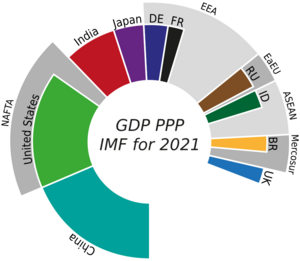Trade bloc facts for kids
A trade bloc is a special club for countries. In this club, members agree to make it easier to buy and sell things with each other. They do this by lowering or getting rid of rules like tariffs (taxes on imported goods) and other barriers to trade.
Think of it like a group of friends who decide to trade video games or snacks without any hassle. It's much easier for them to trade with each other than with people outside their group.
These agreements can be simple deals between a few countries, like the USMCA. They can also be part of a bigger organization, like the European Union. Trade blocs come in different types, from simple free-trade areas to more complex economic unions where countries might even share the same money.
Contents
Why do countries form trade blocs?
Countries join trade blocs to make their economies stronger. By removing trade barriers, they can sell more of their products to member countries and buy what they need more cheaply.
A Look Back in History
Trade blocs are not a new idea. One of the earliest and most famous was the Hanseatic League. This was a powerful group of trading cities in Northern Europe that worked together from the 1100s to the 1600s. Another example is the German Customs Union in the 1800s, which helped German states trade with each other before they became a single country.
The number of trade blocs grew a lot in the 1960s, 1970s, and again in the 1990s. By the late 1990s, over half of all trade in the world happened within these blocs. For a trade bloc to be successful, its members often have a few things in common:
- They are located near each other.
- They have similar levels of wealth.
- They have similar rules for trading.
- Their governments are committed to working together.
Are Trade Blocs a Good Thing?
Not everyone agrees that trade blocs are good for the world. Some people worry that they make countries focus only on trading with their "club members" instead of with the whole world. They believe that global free trade, where every country can trade freely with every other country, is the best way to grow the world's economy.
However, others argue that trade blocs are a step toward global free trade. They think these regional clubs can help countries get used to open trade, making it easier to eventually create a single global system. The debate continues among experts about whether trade blocs help or hurt the global economy.
Types of Trade Blocs
Trade blocs can have different levels of cooperation. A simple bloc might just remove taxes on goods, while a more advanced one might let people live and work freely in any member country.
A common market is a type of trade bloc where goods, services, and resources like workers and money can move freely between member countries. They also agree on some of the same rules for products.
A single market is a more advanced form of a common market. It aims to remove almost all barriers to trade, creating an economy that works like one big country. The European Union is a famous example of a single market.
Examples of Major Trade Blocs
Here are some of the major trade blocs around the world:
- European Union (EU): One of the most integrated trade blocs, with a single market and a shared currency (the euro) for many of its members.
- USMCA: A free trade agreement between Canada, Mexico, and the United States. It replaced the older NAFTA agreement.
- Mercosur: An economic and political bloc in South America, including countries like Brazil and Argentina.
- ASEAN: A political and economic union of 10 countries in Southeast Asia, working towards freer trade in the region.
- African Continental Free Trade Area: A major project to create a single market for goods and services across most of Africa.
Images for kids
-
The member countries of Mercosur, a major trade bloc in South America.
See also
 In Spanish: Bloque comercial para niños
In Spanish: Bloque comercial para niños
- Regional integration
- Continental union






